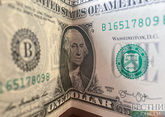The U.S. national debt for the first time ever crossed the $22 trillion mark, Treasury Department data revealed, noting that the latest figure represents a jump of more than $30 billion from where the balance stood at the beginning of February. Thus, the total U.S. national debt is now $22.012 trillion.
The U.S. public debt grew roughly by $2 trillion compared to early 2017 when President Donald Trump took office, according to the U.S. Treasury Department. Moreover, the rate of increase of the debt accelerated after Trump pushed through $1.5 trillion in tax cuts in December 2017.
As a candidate, Trump promised to "get rid of" the national debt, telling he could make the U.S. debt-free "over a period of eight years."
The U.S. debt-to-GDP ratio is projected widen to 117% by 2023.
The advisor on macroeconomics to the CEO of the 'Opening-Broker' brokerage house, economist Sergey Hestanov, speaking to Vestnik Kavkaza, noted that neither the United States nor their lenders have any risks due to the fact that Washington's debt increases. “First, the U.S. national debt is limited, and raising the national debt ceiling requires the consent of the Senate and Congress. Even theoretically, any substantial threats related to U.S. public debt in the next 1-2 decades are impossible,” he said.
In general, a sharp increase in government debt is characteristic of current developed countries. "This is partly due to the fact that there is a large demand for debt securities of developed countries. This is partly due to the need to finance the budget deficit. At the same time, the U.S. national debt is not a record one. For example, Japan has a national debt of over 260% of GDP, and Luxembourg - more than 300% of GDP, and yet, these economies have no significant problems with debt servicing," Sergey Hestanov said.
At the same time, only sufficiently developed countries with large economies and stable fiscal policies can afford high government debt. "Russia had a similar national debt for the last time in 1998 - and then it ended in default," the advisor on macroeconomics to the CEO of the 'Opening-Broker' brokerage house recalled.
Professor of the RANEPA faculty of Finance, Money Circulation and Credit, Yuri Yudenkov, also explained the growth of U.S. government debt by the popularity of U.S. government bonds. “Public debt arises, in the first place, because of external imbalances, when they buy more than they sell, and second, because of the government's issue of securities. At the same time, the public debt service at a refinancing rate of 2% per annum will total $440 billion a year, which is quite a lot and creates certain problems for economic development. The fact is that the U.S. needs to raise the refinancing rate and the Fed wants to increase it to 4-5% - but if this happens, then the government debt service will increase to about $1 trillion a year. As a result, there is only one way ahead - the emergence of distrust of the United States as a country providing the dollar,” he expects.
Yuri Yudenkov emphasized that Russia is not interested in recruiting a large public debt. "First, we have external surplus. Second, even if we want, they will not let us, because the United States urged the whole world not to buy Russian debt obligations. We can only increase our domestic debt. We have to to take into account that nobody lends us. As a result, Russia takes a different path and reduces its foreign debt, which is a positive thing for our economy," the professor of the RANEPA faculty of Finance, Money Circulation and Credit concluded.










